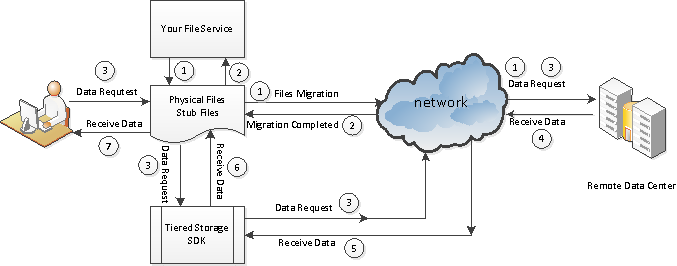Download CloudTier Storage Tiering SDK Setup File Download CloudTier Storage Tiering SDK Zip File
A cloud archive is storage as a service for long-term data retention. Cloud archiving is a service to move the rarely accessed cold data to the public cloud. Public clouds require no special on-premises hardware or software. An organization can reduce its data center footprint and use less power and cooling resources by storing data in the cloud. Public cloud archive attributes include elasticity, abstraction, durability and cost.
Popular public cloud archiving services for cold data — such as Amazon S3 Glacier, Microsoft Azure Blob Storage and Google Cloud Archive Storage — store data for as little as less than a penny per gigabyte. However, some low-cost services take hours to restore data. There may also be extra costs to transfer data back out of the cloud.
The Benefits of Cloud Archiving
Cloud archiving software lets a user optimize their dated storage functions and seamlessly access critical information when needed. Another benefit of cloud archiving software is its flexibility. Different kinds of files, images, videos, and other data can easily be processed and archived by cloud archiving software platforms. This flexibility is critical in today’s business world as companies are constantly changing the way they communicate, and the way work gets done.
Develop Cloud Archiving Software
Companies looking for a cloud archive solution need to consider what each solution offers, including the tools used to access archive data, the cloud portal, the compliance regulations it meets, and the applications that are supported. With the EaseFilter Cloud Storage Tiering SDK, developing the cloud archiving software will be simpler, it provides you an effective and simple way to archive and retrieve data in a way that is cost-effective, compliant, and secure.

CloudTier Transparent Storage Tiering SDK provides you a simple solution to develop the cloud archiving software for unstructured data, integrate your existing on-premises applications with the remote cloud storage infrastructure in a seamless, secure, and transparent fashion, it allows you to free up on-premises storage capacity, by moving out cooler data to the cloud storage, thereby reducing capital and operational expenditures. Cloud archiving is the process of moving data to secondary storage in the cloud, the potential benefits of cloud archiving includes lower costs and easier access, no interruption and change to your existing applications and infrastructure. With the CloudTier Storage Tiering SDK, you can retrieve the archived data dynamically and return the data back to the application transparently, you can restore the archived file automatically and it is completely transparent to the application.
Dynamic Retrieval of Archived Data
Once the file was archived to the cloud, it is very important to user to retrieve the archived file in a fast and simple way. With the CloudTier Storage Tiering SDK, the CloudTier can retrieve the archived data dynamically and return the data back to the application transparently. You can restore the archived file automatically and it is completely transparent to the application or user.
The Advantages of CloudTier Storage Tiering
The CloudTier Storage Tiering provides advantages that include:
- Simplicity. A simple storage solution allows you to integrate the cloud storage transparently.
- Cost-savings. Storage tiering makes it possible to purchase less high-performance storage equipment and leverage the lower-cost cloud storage.
- Protection. With data in your tiered storage system geo-distributed across different locations, you can easily protect against site outages.
- Near-unlimited scalability. On-demand resources are available to meet your business needs and growth.
- Improve efficiency. Archived data can be accessed transparently in real time.
Download CloudTier Storage Tiering SDK Setup File
Download CloudTier Storage Tiering SDK Zip File